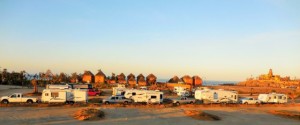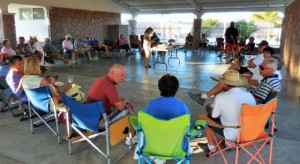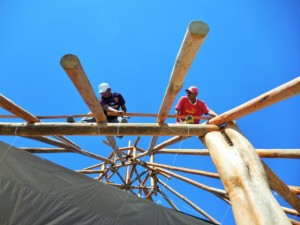
February 27, 2015 – Only a few days ago we were at the Villa Serena RV Park having our Annual Baja Amigos Breakfast Meeting with Dom & Diane from Alberta and Mike & Kelly from Kansas. Dom & Diane had arrived the afternoon before and Mike and Kelly were going to meet us at the Los Cerritos Surf Colony RV Park later in the day. The day started out warm and was only going to get warmer, fortunately we would be a little cooler on the Pacific and have access to a descent pool.
As we left Cabo heading for Hwy 19 we did run across some road construction and a detour, no big deal as it was well marked and straightforward. A couple of years ago at the same intersection we came across detour without any real signage, a bit problematic with an RV Caravan. Just as we were leaving Cabo San Lucas northbound we stopped for fuel and were on our way in no time and a visit to Afrain & Vivianne’s Balnket Factory. Folks enjoyed shopping and bargaining with Vivianne, Afrain was on the mainland resupplying with product.

Before noon we had arrived at the Los Cerritos Surf Colony RV Park, it was anybody’s guess how much our stay was going to cost us? Last month we paid $30 however our next group 2 days later paid $20. We had also spoken to many other RVers that had stayed recently that had paid $20. Before I went to the office I spoke with a couple from BC who were already there and they told me they had paid $20 to start and recently paid $30, only a bit confusing and inconsistent eh? I once explained to Teresa to talk to Roger about our tours, if it was $20 we would stay 2 days, at $30 only 1 and that $40 was more than $30. All he offers is a dirt parking lot, dry camping and no garbage can. The benefit of course is access to the Pool, Hot Tubs, Washrooms, Wifi and expensive Bar & Restaurant. Dinner at La Pasadita was the usual hit, most had Hamburguesas this time. We celebrated Oregon Bob’s birthday and Jose senior’s grandson who turned 1 as well. A memorable evening for sure.
The next day we left for La Paz with our first stop only 30 minutes away in Todos Santos. The gang spread out after parking to see the sites and find a place to eat lunch. We met Roland & Janice and Mike & Kelly at Tequilla Sunrise, we had never been there before and did enjoy the ambiance and food. Back at the RVs at 1 pm we continued to La Paz that included a short stop a Walmart for supplies, not our favourite store but good parking for the group. We got to Campestre Maranatha about 3:30 pm and Adventure Caravans was already there, still lots of room. It was hot, probably over 33C or 90F and with all the rigs no air conditioning. We set up organized some electrical issues and Lisa summoned Gabi the Laundry Lady who remarkably showed up within 2 hours to collect up folks clothe. At the first opportunity we hit the pool to cool down, it was simply wonderful.

Day 2 in La Paz and thankfully it had cooled down. I made a water run with Roland the off to Ibarra’s Pottery and the downtown Mercado (Market). After dropping the group off I headed back for a shower, lunch and a siesta. The gang had a good time, many dropped by the Yeneke Hotel, a little weird and creepy but interesting, dead monkey and all. Only a couple of people joined us at Los Magueyes for dinner, folks were tired and they do need to eat that stuff in the freezer. Our last day in La Paz included a visit to the Malecon, more pool time and a joint Happy Hour with Dom & Diane’s group of Baja Amigos. A great day all around.
This morning we head off northbound. Dennis has agreed to drop off for a couple of days and return with Dom & Diane. Chris & Dixie who dropped off in December are returning with us.

Did you know?
Baja California peninsula is a vast territory stretching for nearly 1100 miles south from the border of California-USA with Mexico. It is almost as long as the west coast of the US but, the average width of the peninsula is only 50-75 miles. The East coast of Baja is bordered by the Sea of Cortez, supporting the largest and most varied population of whales in the world, as well as one of the last sanctuaries for the endangered Fin-back and Blue whales, the largest of the cetaceans (twice the size of Gray whale). Why such a bounty and diversity? The Sea of Cortez is exceptionally nutrient-rich, especially around islands and the tides flowing around the islands form gentle water-upheavals, mixing oxygen, salt water, and sediments from the bottom, creating perfect conditions for plankton growth. The plankton (microscopic organisms) are the base of the ecological food chain. The small fish and crustaceans feed on plankton, bigger fish feed on small fish, etc. The West coast of Baja is bordered by the Pacific Ocean. Here is where the Gray whales migrate to, from the Bering Sea and North Pacific. Every year virtually the entire population of Grays led by the pregnant females makes the 6000 mile migration to the calving lagoons of Baja California. Here, from mid-December to mid-March, they will give birth and nurse their offspring.


The following whales can be found at various times of the year off Baja California and Baja California Sur; BLUE WHALE (Balaenoptera musculus), FIN WHALE (Balaenoptera physalus), BRYDES WHALE (Balaenoptera edeni), MINKE WHALE (Balaenoptera acutorostrata), HUMPBACK WHALE (Megaptera novaeangleae), GRAY WHALE (Eschrictius robustus), SPERM WHALE (Physeter microcephalus), DWARF SPERM WHALE (Kogiasimus), PILOT WHALE (Globicephala macrorhynchu), FALSE KILLER WHALE (Pseudorca crassiden).
There are three lagoons on the Pacific coast of Baja where Gray whales find the optimum conditions for their nurseries. The lagoons are government protected marine parks, and access for whale watching is only allowed on permit basis. Only motor boats (pangas) with trained guides may be used for whale watching. Sea kayaking in the lagoons is prohibited during the whale migration.
1) Scammon’s Lagoon is Baja ‘s most northern whale watching location (and the closest to the US), about 440 miles South of San Diego, California. Scammon’s is also the largest of the three whale watching lagoon; Usually, well over 1000 whales are here during each season and, on some exceptional seasons, Baja whale watching experts counted over 2000 Gray whales, (including baby whales).
2) San Ignacio Lagoon is about 530 miles South of the border, somewhat smaller, slightly fewer whales but, exhibiting note-worthy different behaviors.
3) Magdalena Bay, 800 miles from the border, is the furthest South, and least protected lagoon on the Pacific coast of Baja. It is perhaps one of the main reasons why, the numbers of the Gray whales here fluctuate considerable from season to season.

Conclusion: The lagoons of the Pacific coast of Baja have the greatest concentration of whales per square mile, but only from mid-December to mid-April, with the numbers peaking in January, February & March, and only Gray whales. The Sea of Cortez is blessed, maybe not with such great concentration of whales per square mile, but with a variety of whale species, and high chances that you will see some whale activity practically any time of the year (some species live here all year, see table above). If Gray whale watching is your main interest, the Pacific lagoons of Baja are the right places during January & February & March of every year. If your interest is sea kayaking expedition-style, in a spectacular marine environment with opportunities of encountering a rich variety of sea life including the true giants of the Earth, the Blue whales, our sea kayaking trips on the Sea of Cortez are the best choice.
Whales are just so amazing. They jump, flip, slap, stand, sing and even give rides to oceanic hitchhikers! Here are some interesting facts about the whales that visit Baja California Sur.
FLUKING – When the larger whales take a deep dive, they often arch their bodies and move some of the mass above water to help propel the dive in a steeper angle. As the whale proceeds forward and then down, the last thing visible before the whale is completely submerged is usually the underside of the tail flukes. The shape and markings on the undersides of whale tails are all unique, which enables researchers to tell the whales apart.
TALLEST BLOW – A ‘blow’ or ‘spout’ is the cloud of water droplets produced above a whale’s head when the whale exhales. Every species of whale has a differently shaped blowhole (some even have two) which results in differently shaped spouts. The tallest blow belongs to the blue whale with blows of up to 12m (39ft 5in).
SPYHOPPING – When a cetacean wants to take a look around, or sometimes at each other, they stick their head up and out of the water. Spyhopping is controlled and slow, similar to a human treading water. Relying on exceptional buoyancy control and positioning with pectoral fins, they can stay above the surface of the water for minutes at a time.
LARGEST APPETITE – A blue whale eats up to 4 tons of krill every day. This is equivalent to eating a fully grown African elephant.
LONGEST SONG – Male humpback whales sing the longest and most complex songs in the animal kingdom. Each song lasts for half an hour or more and consists of several main components. The songs can be heard underwater hundreds, or even thousands, of miles away.
LONGEST MIGRATION – The gray whale has been known to undertake the longest known migration of any mammal. Along the North American coastline, they swim from their winter breeding grounds in Baja California Sur, Mexico, to their summer feeding grounds in the rich waters of the Bering Sea in the Arctic and back again. This amounts to a total annual distance of 12,000 to 20,000 km (7452 to 12,420 miles). In a gray whale’s lifetime of 40 years or more, this is equivalent to a return trip to the moon.
SLEEPING – Whales do not sleep like horses, dogs or humans. Frequently, they rest on the surface of the sea or catnap for a few moments while they are swimming. Each side of the brain takes turns to ‘switch off’ while the other half stays vigilant and keeps the animal breathing, which is a voluntary action in cetaceans.
EYE PROTECTION – When whales and dolphins open their eyes underwater, special greasy tears protect them from the stinging salt.

HITCHHIKERS – A ‘whale louse’ Cyamus boopis, is actually more like a crab or a shrimp, (lice are insects, cyamids are crustaceans). Gray and humpback whales each have their own variety, as the lice are very particular about which species of whale they live on. They are not all bad, they feed on the dead, shedding skin and damaged tissue which is beneficial to the whales. Barnacles are also a fact of life for gray whales and there can be hundreds of pounds of barnacles on an individual. These barnacles attach themselves to gray whales in the lagoons when the whales are born and are on them for as long as they are alive. When the barnacles die and fall off they leave a small round white circle or ring. Barnacle scars create a unique pattern on each whale, which can help in identifying the gray whale.
PREGNANCY – Gray whales have a special adaptation called delayed implantation; after becoming pregnant, the embryo does not start developing in the mother’s body until a few months.
BABY WHALES – Whales are mammals, so calves nurse on their mother’s milk for 6 to 8 months. Each day they will consume about 50 gallons of mother’s milk and gain 60 to 70 pounds. Whale milk is very rich, about 53% fat (Human milk is about 2% fat.
PARASITES – The largest tapeworm in the world was found in a whale, and measured over 30 meters long!
WEIGHT LOSS – a 30-ton whale will expend so much energy on its migration to the Baja lagoons that it may lose 10 to 13 tons of its blubber; it eats little or nothing in the breeding grounds. By early spring most gray whales are heading back to the northern feeding grounds from Baja California Sur and will regain the weight for the following year’s journey south.
SPEED – Fin whales are the fastest of all cetaceans, reaching speeds of 37 kilometers per hour (22 mph).



